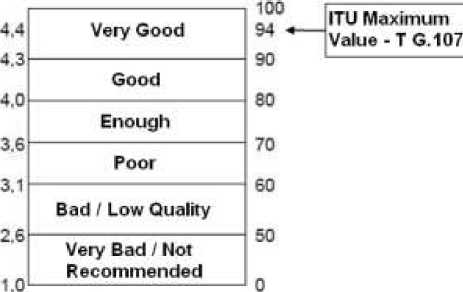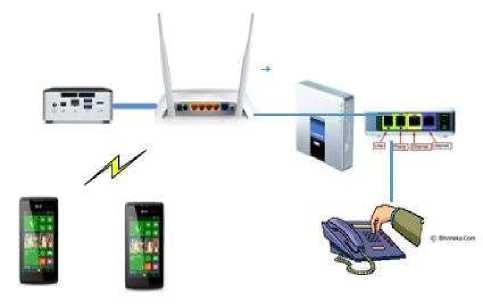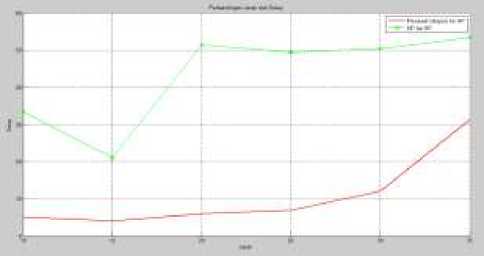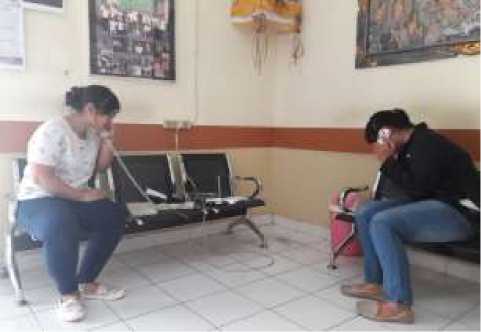Implementation of Hotspot Network for Internal Campus Communications Utilizing Smartphone and Free Software
on
Journal of Electrical, Electronics and Informatics, Vol. 1 No.1, February 2017
Implementation of Hotspot Network for Internal Campus Communications Utilizing Smartphone and Free Software
Sudiarta Pande Ketut1, Ardana I Putu2
Jurusan Teknik Elektro dan Komputer
Fakultas Teknik Unud
Bali Indonesia sudiarta@unud.ac.id
Jurusan Teknik Elektro dan Komputer Fakultas Teknik Unud
Bali Indonesia ardana@unud.ac.id
Abstract - VoIP (voice over internet protocol) telephone communication using a data network. There is a change in switching from circuit switching technology into packet switching. Phone exchange can now use the Personal Computer equipped VoIP applications. Even the development of mobile phone technology to make VoIP communication can be performed utilizing the Smartphone. VoIP applications commonly use such as WhatsApp, Line etc. However, this application will cut the user data packets and often the quality is not satisfactory due to limited bandwidth and location of the remote server. During this time, Udayana University campus at several locations has been equipped with Hotspot network is mostly used to connect to the Internet. Hotspot network can also be used for voice communications with VoIP technology by adding a VoIP server. This concept not raises communication costs and should produce sound quality will be better because of the close location of the server.
Because that researchers need to develop a model of telephone communication network utilizing Smartphone hotspot and students to be able to communicate in a campus environment. Method of this research is to develop a network utilizing hotspots and VoIP telephone exchange using the mini PC installed software FreePBX. On the side of the Smartphone using the free soft phone application and for aircraft used FXS analog phone as a codec. Tests will be performed for the communication between Smartphone and Smartphone to FXS terms of QOS and MOS produced. The results obtained, if the latency and packet loss have a value corresponding to the Real Time Protocol (RTP), the obtained MOS appropriate for the codec used while with the same codec if the value of packet loss and latency results are high then MOS obtained be small or less good quality. So the quality of VoIP is highly dependent on the quality of the signal obtained hotspot. In general, VoIP communication using a Smartphone connected to the server on the network hotspot mini pc can be used as a voice communication on campus.
Index Terms—VoIP, Smartphone, Wireless.
The development of telephone technology experienced a fundamental change of circuit switching into packet switching. Application like Whatsapp and Line using this technology so that the packet data on the Smartphone to do a phone call. This type of phone technology called VoIP (voice over internet protocol). Phones using the LINE or Whatsapp is not free because it is paid on the cutting packet data. The main problem of the use of technology Line or Whatsapp is the sound quality due to the need to use the Internet and away the position of the server. From Line and Whatapps emerge thought, starting from the Department developed a VoIP-based telephone network by utilizing the campus hotspot network. Hotspot is an area that is covered by WiFi signal so that those who have a laptop, PDA, Smartphone, and other WiFi devices can be connected to the network [1]. Research titled “Penerapan Teknologi Voip untuk Mengoptimalkan Penggunaaan Jaringan Intranet [2]” already utilizing VoIP over cable. Other research titled “Analisa Kinerja Voice Over Inernet Protocol (VOIP) Melalui Mobile Wimax 2011 [3]” utilizing VoIP technology over WiMAX.
Campus society can make phone calls from a Smartphone, laptop, or a regular telephone (POTS). Smartphone is a cell phone that has high rate capability with functionality that resembles a computer [4]. All these facilities are free as are local telephone exchange and use only the campus hotspot network. Students with smartphone can contact lecturer or employees without fear of a data packet is reduced.
In this study developed a model of telephone communication using VoIP technology, utilizing the telephone exchange of a PC and free software. Results are expected to facilitate telephone communication in the campus environment, both from Smartphone to Smartphone, Smartphone into a laptop, or Smartphone to the PSTN. All facilities were developed not use pulse paid. Packet data used to use the campus network hotspot.
The main problem is the quality of VoIP voice, especially when applied to the hotspot network. Indoor and Outdoor conditions greatly affect the quality VoIP received. Distance measurement will affect the sound quality, especially when tested under Indoor conditions.
-
a. Object
-
- 2 unit hotspot device that will provide access to
Smartphone
-
- 1 unit mini PC as a server VOIP with SIP
technology
-
- Smartphone devices installed softphone
-
- 1 unit FXS is connected to POTS Telephone
-
b. Method
START
Study O Literature
Voip Device Installation
Voip Device Testing

Analyzing the result
Conclution
To measure the quality of VoIP services, the parameters will be calculated is the MOS (Mean Opinion Score). Because the process relied on the test parameters measured, the results of this evaluation with Objective-called MOS. Based on ITU-T Recommendation P.107, the MOS value can be obtained by first calculating the R factor as follows [5]:
R = 94.2 - Id- Ief
with,
Id = 0.024 d + 0.11 ( d- 177.3 ) H( d-177.3 ) and
Ief = 7 + 30ln( 1 + 15 e )
Id is a factor with quality deterioration caused by the effect of delaying or d, while Ief is a factor of decrease in quality caused by compression techniques and packet loss that occurred or E, and H is a step function
with conditions.
- {0
if x < 0
if x ≥ 0
With R-Factor has been obtained, MOS value will be obtained with the following correlation :
Equation used to Getting MOS measurement results are :
R = 94.2 - 0.11 * (d - 177.3) * H(d - 177.3)
- 0.024 * d - 30 * ln(1 + 15 * e)
-
- The device is selected hotspot wireless brand TP-LINK TP-MR3420 is a type of device that is equipped with WAN hotspot using 3G or using Ethernet.
-
- Device FXO / FXS is a device to interface to analog devices like a regular phone or to the PSTN.
-
- Installing FreePBX program conducted on the device using the Intel NUC Flash Disk using FreePBX Version 10.6.
-
- Smartphone.
R : transmission quality
d : delay
H : heavyside function with requirement H(x) =
0, ifx < 0 and H(x) = 1, if x = 0
e : percentage of packet loss happen (in
decimal)

Fig. 2. Research Tools
MOS Level of Satisfaction R Factor

b. Server Configuration
The results of the server configuration as shown in Figure 3 by making 5 extension 1001, 1002, 1003, 1004, 1005 dn.

Figure 3. Configure extension on the server
Communication has been done is stored in the server FreePBX. Whether the communication was successful or not everything can be seen in conversation log, as shown in Figure 4
a. Testing Scenario
Test conducted by research scenario as in figure 1.

Fig. 1. Testing Scenario

Figure 4. Log Communication server FreePBX
c. Testing Result Outdoor Condition
VoIP Quality Testing (MOS) associated with QOS results include delay and packet loss in outdoor conditions do around Sudirman campus FT Building and get results like figure 5
The tools used in the research are:
-
- Device Intel NUC is kind of a mini PC that size is very simple, equipped with hard disk capacity of 500 GB. Memory 4 GB.

Figure 5. The relationship of distance and delay outdoor conditions
Figure 6 shows the relationship with MOS to measure outdoor conditions

Figure 6. Results of Measurement distance relationship and MOS outdoor conditions
-
d. MOS Measurement Indoor Condition
MOS measurement conditions Indoor conducted at several locations on campus Bukit, namely LAB DSK, Microcontroller Lab, Department of Electrical Engineering Building, Building Dean. Results Measurement in Building Dean are shown in Table 1.
TABLE 1
RESULTS OF MEASUREMENTS IN THE HOUSE DEAN LOCATION INDOOR
|
Device |
Distance |
Average |
MOS |
|
Hp to phone |
4m |
15.416 |
4.5 |
|
Hp to HP |
24.081 |
4.5 | |
|
Hp to phone |
7m |
793.644 |
1.3 |
|
Hp to HP |
9.951 |
4.5 | |
|
Hp to phone |
13 |
119.604 |
1 |
|
Hp to HP |
127.62 |
1 | |
|
Hp to phone |
10m |
9.987 |
4.5 |
|
Hp to HP |
33.663 |
4.5 | |
|
Hp to phone |
14m |
23.778 |
4.5 |
|
Hp to HP |
40.583 |
4.5 | |
|
Hp to phone |
10m |
119.48 |
1 |
|
Hp to HP |
1286.99 |
1 |

Figure 7. Image data retrieval process in the Department of Electrical Engineering, Bukit Campus.
Figure 7 shows the measurement process Voice Quality (MOS) and network quality (QOS) conducted in the area indoor building electrical engineering majors Hill campus. The results obtained are shown in Table 2 shows the location and condition of QOS at the time of measurement.
TABLE 2.
RESULTS OF MEASUREMENTS IN THE AREA OF INDOOR DEPARTMENT OF ELECTRICAL ENGINEERING, BUKIT CAMPUS
|
Device |
Distance |
Average |
MOS |
|
Hp to phone |
3 m |
16.37 |
1 |
|
Hp to HP |
9.988 |
4.5 | |
|
Hp to phone |
9 m |
9.927 |
4.5 |
|
Hp to HP |
33.621 |
1 | |
|
Hp to phone |
6 m |
5.854 |
4.5 |
|
Hp to HP |
14.452 |
4.5 | |
|
Hp to phone |
7 m |
6.036 |
4.5 |
|
Hp to HP |
25.868 |
1 | |
|
Hp to phone |
7 m |
50.776 |
1 |
|
Hp to HP |
12.424 |
4.5 | |
|
Hp to phone |
3 m |
16.37 |
1 |
|
Hp to HP |
9.988 |
4.5 |
Measurements were carried out at the site of Indoor
Building dean FT Unud are shown in Table 3
TABLE 3
RESULTS OF MEASUREMENTS IN THE INDOOR AREA BUILDING BUKIT CAMPUS DEAN FT UNUD
|
Device |
Distance |
Average |
MOS |
|
Hp to phone |
4m |
15.416 |
4.5 |
|
Hp to HP |
24.081 |
4.5 | |
|
Hp to phone |
7m |
793.644 |
1.3 |
|
Hp to HP |
9.951 |
4.5 | |
|
Hp to phone |
13 |
119.604 |
1 |
|
Hp to HP |
127.62 |
1 | |
|
Hp to phone |
10m |
9.987 |
4.5 |
|
Hp to HP |
33.663 |
4.5 | |
|
Hp to phone |
14m |
23.778 |
4.5 |
|
Hp to HP |
40.583 |
4.5 | |
|
Hp to phone |
10m |
119.48 |
1 |
|
Hp to HP |
1286.99 |
1 |
-
IV. DISSCUSION
VoIP communication using a hotspot network using Smartphone and devices for voice communications codec to function properly using a server NUC mini PC with free software PBX. The test results linking network quality (QOS), namely delay and packet loss and Voice Quality (MOS) MOS obtained that is highly dependent on the quality of the current network. For the experiment compared Indoor Outdoor obtained sound quality at the site as a function of distance Outdoor obtained average yields better than the measurement Indoor conditions. This is partly due to the amount of reflection room Indoor conditions that result in network quality (QOS) to be less well so the sound quality (MOS) to decrease. In normal conditions MOS will follow Codecs are used to communicate. In this study tested using G711 codec (Smartphone to Smartphone) and G729 codecs from FXS to Smartphone.
In general, VoIP testing using hotspot network can function well if the quality of the network in good condition.
communication voip, produce sound with good quality according to the MOS codec used.
From the research conducted, the following suggestions:
-
1. Research can be developed to determine the relationship of signal quality associated with MOS detail Hotspot outdoor and indoor conditions.
-
2. To determine the MOS value of the type of codec that use need to be compared using each type of codec.
-
3. Research can be developed using communication soft phone on the laptop to hand phone or codec.
-
4. Research can be developed using Line PTT communication POTS network like PSTN to VOIP.
References
-
[1] ITB Network Information Center,
https://nic.itb.ac.id/ina/hotspot-itb, diakses 17 Maret 2016.
-
[2] Pande Ketut Sudiarta, Penerapan Teknologi Voip untuk Mengoptimalkan Penggunaaan Jaringan Intranet Kampus Universitas Udayana, Universitas Udayana, Prosiding Hibah Strategis Nasional 2009).
-
[3] Endah Budi Purnomowati, Analisa Kinerja Voice Over Internet Protocol (VOIP) melalui Mobile Wimax, Universitas Atmajaya, Jurnal Elektro Volume 4 Nomer 2 Tahun 2011.
-
[4] Ponsel Cerdas, https://id.wikipedia.org/wiki/Ponsel_cerdas, accessed 17 Maret 2016.
-
[5] Quality of Service (QoS) dan Pengukurannya, https://www.academia.edu/5681701/Qo_S, diakses 24 Oktober 2016
From research conducted can be summarized:
-
- Communication VoIP can be implemented on the Hotspot network by adding a VoIP server device using a PC. Calls can use a Smartphone or codec connected analog telephone.
-
- Voice Quality in VoIP communications depend on Quality Network Hotspot at the time of the communication. At the time of packet loss and delay in accordance with the standards of
37
Discussion and feedback